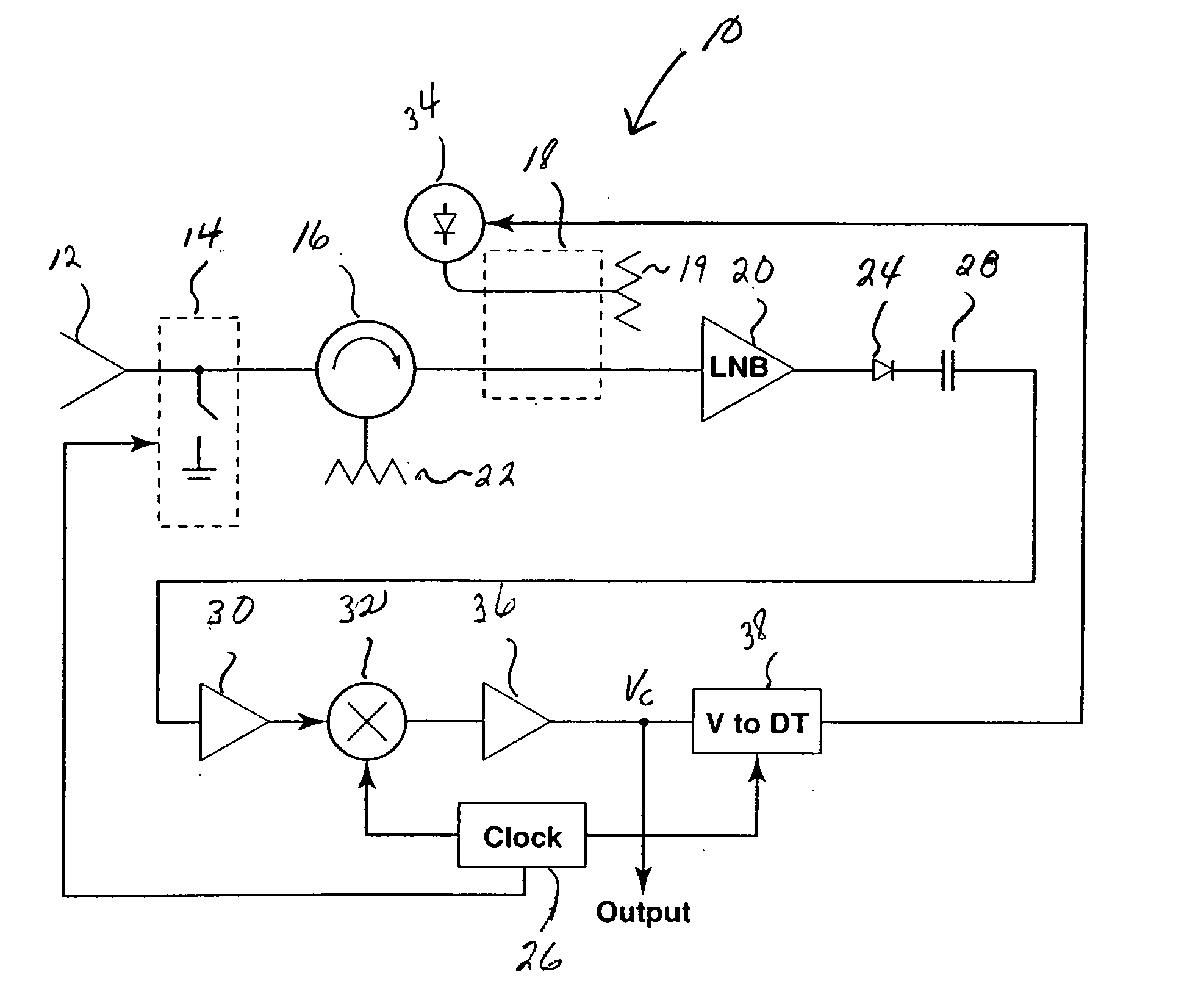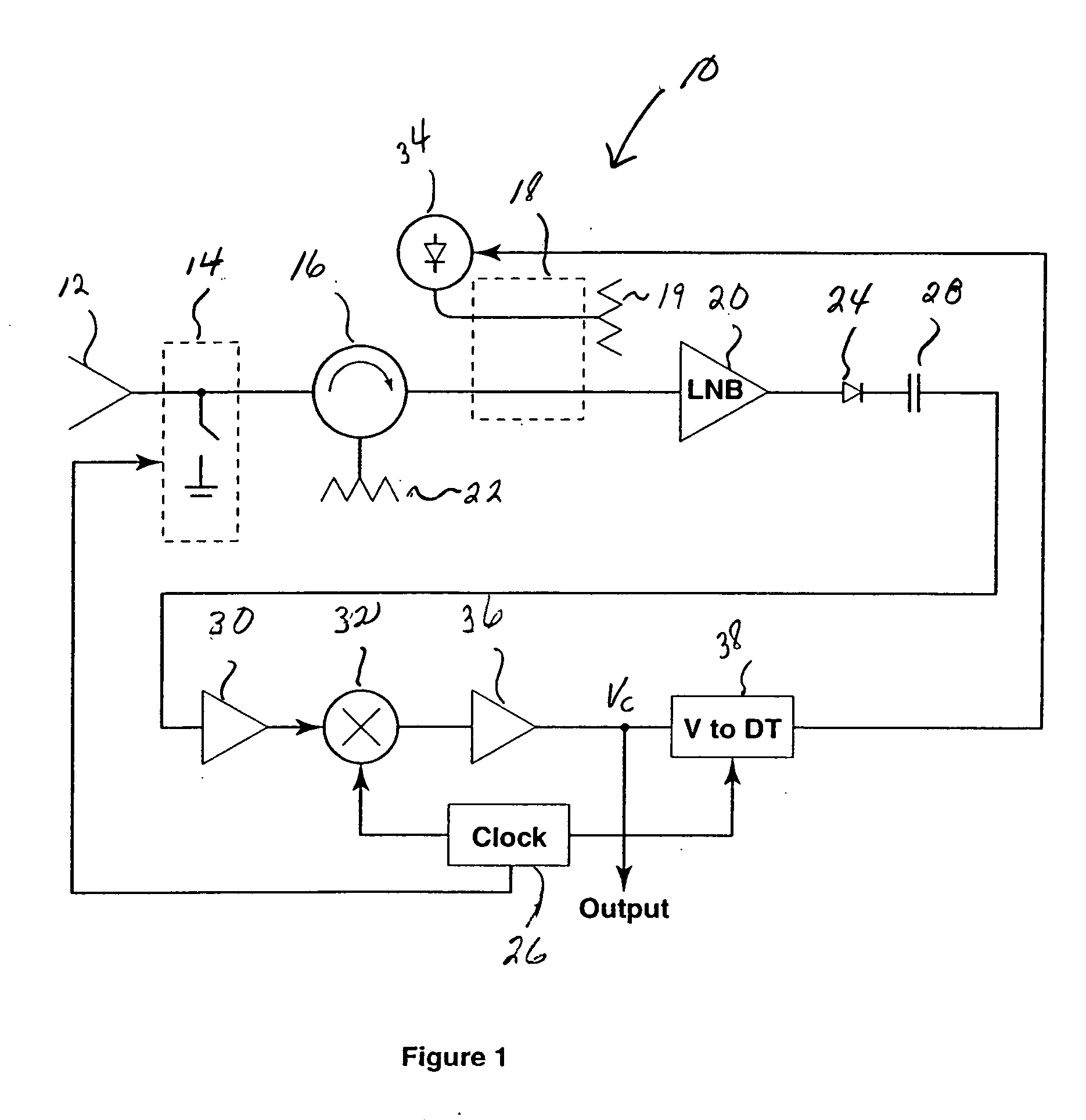Remote temperature measuring system for hostile industrial environments using microwave radiometry
a technology of microwave radiometry and remote temperature measurement, applied in the field of microwave radiometry, can solve the problems of inability or undesirable direct physical contact, mechanical difficulty in maintaining contact for a long time, and inability to perform direct physical conta
- Summary
- Abstract
- Description
- Claims
- Application Information
AI Technical Summary
Benefits of technology
Problems solved by technology
Method used
Image
Examples
first embodiment
A first embodiment 10 of remote temperature measuring system using microwave radiometry (or microwave radiometer) of the present invention is shown in FIG. 1. A low-loss antenna 12 (such as a waveguide horn or other waveguide antenna) receives the microwave power radiated in a bandwidth B (Hz) from the object (not shown) whose temperature is to be measured. In the present embodiment, the bandwidth extends from approximately 12 GHz to approximately 13 GHz, but other microwave frequencies and bandwidths can be used. A low-loss single pole-single throw microwave switch 14 alternately allows the incoming microwave energy from the antenna 12 to pass on to the rest of the system, (the PASS mode) or blocks it and becomes a highly reflective circuit element (the BLOCK mode). In the PASS mode, the switch 14 permits the incoming energy to pass through the circulator 16, through the main arm of a directional coupler 18 into an LNB 20. In the, first embodiment, the microwave switch 14 is prefe...
second embodiment
A system 110 reflecting a second embodiment 110 of the present invention is shown in FIG. 2. In system 110, a low loss antenna 112 receives the microwave power from the object (not shown) whose temperature is to be measured. A low-loss microwave switch 114 alternately allows the incoming microwave energy to pass on to the rest of the system 110 (the PASS mode) or blocks it and becomes a highly reflective circuit element (the BLOCK mode). In the PASS mode, the switch 114 permits the incoming microwave energy to pass through the circulator 116 into the LNB 120. In the PASS mode, LNB 120 filters and amplifies the incoming power, converts it to a lower frequency and outputs the amplified and downconverted power to an internal IF amplifier. The amplified power output of the LNB is then detected by a microwave detector 124.
In the BLOCK mode, the switch 114 blocks the incoming power from the microwave source and reflects power from both an ambient load 122 and a noise-injection source 1...
third embodiment
Operation of Third Embodiment During Electromagnetic Heating Processes
Because the typical microwave power sources used for electromagnetic heating emit copious amounts of harmonics, it is not generally possible to employ microwave radiometry to estimate the temperature of objects while they are being subjected to microwave heating. For example, the noise power emitted from a typical 1-KW microwave magnetron operating at a fundamental frequency of 2.45 GHz is several milliwatts at 12 GHz, which is the frequency range we have found to be useful for microwave radiometry. Such noise power exceeds the thermal noise radiated by heated objects, making the latter impossible to measure. One possible way to avoid this problem is to install a high-power waveguide filter between the microwave power source and the chamber holding the material to be heated. This approach is impractical because a filter with the requisite power-handling capacity and rejection characteristics at the harmonic frequ...
PUM
 Login to View More
Login to View More Abstract
Description
Claims
Application Information
 Login to View More
Login to View More - R&D
- Intellectual Property
- Life Sciences
- Materials
- Tech Scout
- Unparalleled Data Quality
- Higher Quality Content
- 60% Fewer Hallucinations
Browse by: Latest US Patents, China's latest patents, Technical Efficacy Thesaurus, Application Domain, Technology Topic, Popular Technical Reports.
© 2025 PatSnap. All rights reserved.Legal|Privacy policy|Modern Slavery Act Transparency Statement|Sitemap|About US| Contact US: help@patsnap.com



